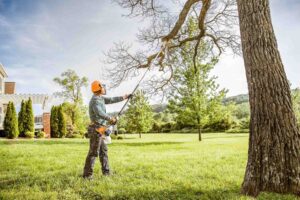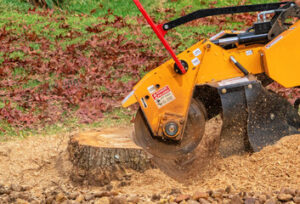Tree Service Irvine CA is removing overgrown branches from trees, shrubs, and hedges. It improves the health, strength, and appearance of a landscape.
When pruning large or heavy limbs, it is important to follow a three-step process to prevent damage to the bark. Begin with the underside of the limb, then move to the top side and finish at the branch bark ridge.

Tree trimming can be dangerous, especially if you don’t know what you’re doing or use the wrong tools. If you have a large tree with high limbs that need to be trimmed or trees near power lines, it’s best to call in a professional who is trained to work safely and uses proper pruning techniques. The best time of year to prune your trees is in late fall or winter when they are dormant. This prevents them from losing sap and makes it less likely that insects or fungi will cause additional damage.
Regular trimming will help the overall health of a tree by eliminating dead or diseased branches and reducing the risk of injury from falling limbs during heavy storms or high winds. Proper trimming can also help prevent overgrowth and reduce the need for future corrective pruning.
When you trim a tree, be sure to cut outside the bark ridge and angle your cuts downward. This will keep water from settling into the wound and causing rot. Additionally, never remove branches that are growing straight up. Cutting these branches can cause the tree to lean or fall, which could seriously injure someone or damage property.
In addition to preventing injuries and property damage, regular tree trimming will enable sunlight to reach lower sections of the landscape, thereby improving the health of any nearby gardens or lawns. This can be particularly beneficial in areas where damaging storms frequently occur and where power lines are located. Having properly trimmed trees can also make it easier for homeowners or maintenance workers to mow lawns or tend to garden beds.
A well-groomed and maintained tree enhances the overall look of a landscape. Proper trimming helps preserve the shape of a tree and removes dead or diseased branches that pose a safety hazard. It can also prevent the spread of pests from one part of a tree to other parts. Additionally, a professional trimming service can remove branches growing into structures such as homes or power lines.
A good time to trim a tree is during its dormant season, which usually occurs from late fall through the winter. This is because tree wounds heal more quickly during this period. Additionally, pruning during the dormant season reduces the risk of transmitting disease pathogens from one plant to another.
In addition to removing dead or damaged branches, proper pruning can stimulate a tree’s growth and shape it more desirably. It can also improve a tree’s symmetry, especially when it grows too densely. Thinning out dense clumps of branches allows for more sunlight to reach inside the canopy, which can encourage healthy, vigorous growth.
Another important reason for regular trimming is to prevent the growth of limbs that obstruct walkways or are too close to buildings, homes, cars, and power lines. These limbs can easily fall off if left unattended and cause extensive damage to property and injury to people.
Lastly, regular trimming can help protect flower gardens and vegetable beds from excessive shade. Often, trees and shrubs grow too thick in certain areas and block sunlight from reaching grass, flowers, and vegetables beneath them. Getting rid of these overgrowths through pruning can allow grass and vegetation to thrive while preventing trees from becoming unkempt and overgrown.
During a trim, an experienced arborist can assess the health of a tree and make recommendations about what needs to be done for its safety and aesthetics. Keeping your trees, shrubs, and hedges properly pruned can ensure their long-term beauty and health, as well as add value to your home and business.
Tree trimming is essential for the health of your trees. It removes dead branches that can fall during a storm and damage your house or car. It also reduces the chances of injury to people and pets that may walk or play under the tree. It can also prevent damage to your property from overhanging limbs that rub against your home or car and block sunlight from reaching grass, flowers, and other plants.
Trimming can also help trees grow healthier by allowing them to use their resources more efficiently. This can mean less stress and increased growth and fruit production. It can also reduce the risk of disease by removing dead or infected branches before they spread to other parts of the tree.
Aside from making your yard look more beautiful, properly maintained trees add value to your property. They can increase your property’s curb appeal and make it more appealing to potential buyers if you decide to sell your home. Well-maintained trees are also a great way to improve your home’s energy efficiency by reducing the amount of heat or cold that it absorbs.
Whether you want to enhance your curb appeal, increase the value of your home, or keep your yard safe and healthy, a professional tree service can help. They will carefully assess your yard and trees to determine the best action for the work needed. Then, they will trim or prune the appropriate branches to achieve your desired results.
While pruning and trimming are similar, there are some important differences. Pruning involves removing diseased, damaged, or dead branches while trimming focuses on shaping and thinning the plant. It is best to prune or trim a tree while it is dormant, in late winter or early spring, before buds develop. This allows the cuts to heal faster and avoids the risk of damage to new buds and shoots. It is also important to understand that different species and varieties of trees require varying levels of pruning or trimming, so it is best to leave this task to professionals.
Tree trimming is a way to enhance the beauty of your property’s landscape. It helps to create a more balanced look, and it can also promote the growth of healthy foliage. In addition, it can prevent certain types of pest infestations that may otherwise damage your trees and shrubs.
While some people believe that trimming should be left to professionals only, the fact is that anyone can learn how to cut their shrubs and small hedges. It is just a matter of knowing the right tools and techniques to use so that you can keep your plants at their ideal size for maximum health and appearance.
Aesthetic pruning is a practice that involves the creative interpretation of small trees and shrubs. This type of horticulture combines the artistic skills of the pruner, the essence of the plant, and its surroundings to achieve a design that complements the landscape.
The first step in aesthetic pruning is to become familiar with the plants that you want to prune. Please look closely at them from all angles and note any areas of regrowth or unnecessary bulk. It is important to understand how each plant was originally planted and how it has grown over time. This will help you determine the best way to shape it and where you can adjust aesthetics, resolve spatial problems, or enhance a particular aspect of the landscape.
When doing aesthetic pruning, it is essential to remove diseased or dead branches to avoid potential liability issues. It is also a good idea to trim away any branches that obstruct your view or block sunlight from entering your home. It is also a good idea to get rid of any limbs growing too close to your house, as they can cause structural damage and lead to pest infestation.
It is a good idea to schedule regular trimming throughout the year, as this will help to maintain the overall symmetry and visual appeal of your landscape. A professional arborist can recommend the best times of the year to perform this task, depending on weather conditions and the species of plants that you have. Generally, late winter or early spring is the best time to trim, as most plants are dormant and less stress-resistant.
